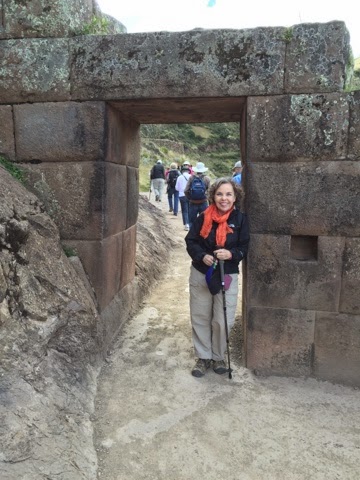Today was an unbelievably packed day. We were up and headed for the airport by 6:30 am. Our flight to Cuzco was comfortable and we arrived at 10:30. We boarded our private bus and drove through Cuzco (we'll be back later) to Qenko. This is an archaeological site with naturally occurring rock formations. It is believed to be a place of worship and where sacrifices took place. This photo shows the amphitheater and, on the right, a monolithic rock which may have resembled a puma or other spiritual symbol. There is evidence the stone was worshipped.
We did get a lovely view of Cuzco from the ruins.We continued our journey by bus to the Urubamba Valley, which is at 9,000 ft elevation, to reduce our chances of altitude sickness from Cuzco, which is at 11,000 ft.
Along the way we discovered these villagers who were having an annual market to sell (or trade) livestock. Loved the woman selling her chicken and guinea pigs. And I love accessorizing a traditional outfit with a Mickey Mouse baseball cap.
We stopped to eat our box lunches overlooking the Urubamba River Valley. Below we could see the village of Taray, with its neatly drawn streets and squares. Pepe said this was one of the villages created by the Spanish to provide better control over the indigenous people.
We then continued to drive through the valley and Pepe pointed out the farming in these communities, particularly the quinoa. Although it is a staple of the Peruvian diet, it is becoming expensive because of the world demand.
A highlight of the day was visiting the Inka Pisac ruins. Noteworthy are the agricultural terraces carved into the steep hilłside. They enabled greater food production than would normally be possible. We also saw the Inka tombs, holes dug into the side of the mountain where bundled mummified bodies were buried.
We took a short hike to the doorway of the "hitching post to the sun." This was an important ceremonial center and Pepe showed us how the door could be blocked off to prevent entrance. Also note this door is a trapezoid -as are many doors and windows in Inka construction. This enabled the buildings to better withstand earthquakes.
Several traditional Andean weavers ply their craft while they sell their wares outside of the ruins. Two more impromptu stops on our way to our final destination. One to see a woman roasting guinea pig on a stick. A full meal with the pig is about $11.
Another stop was in a small village next to where we are staying. They were celebrating "the Crossing of the Crosses" which is held about this time each year in these villages. It coincides with the appearance of the "Southern Cross" constellation in the night sky. (We can't see it in US.) It is visible in early winter (May), and signifies the end of the harvest. The celebration includes 7 crosses and a parade.
We had an early dinner at our hotel The Urubamba and turned in early.















No comments:
Post a Comment